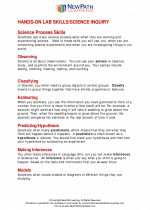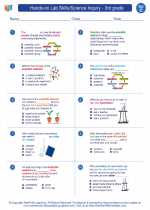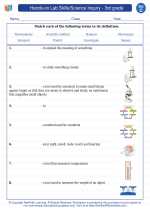Genetics
Genetics is the study of genes and how traits are passed from parents to offspring. Genes are segments of DNA that contain the instructions for building and maintaining an organism. Every living organism, including plants and animals, has a set of genes that determine its unique characteristics.
Key Concepts in Genetics
- Genes: These are the basic units of heredity. They determine traits such as eye color, height, and susceptibility to certain diseases.
- Alleles: These are different forms of a gene. For example, the gene for eye color has alleles for blue, brown, green, etc.
- Chromosomes: These are long, thread-like structures found in the nucleus of cells. They carry genetic information in the form of genes.
- DNA: Deoxyribonucleic acid (DNA) is the molecule that carries genetic instructions. It is a double helix structure made up of nucleotides.
- Genotype: This refers to the genetic makeup of an organism, while phenotype refers to its observable traits.
- Mutations: These are changes in the genetic material (DNA) that can result in new traits or genetic disorders.
Study Guide
To understand genetics, it is important to grasp the following concepts:
- What are genes and how do they determine traits?
- How do alleles contribute to genetic variation?
- What is the structure and function of DNA?
- How are genes organized on chromosomes?
- What is the relationship between genotype and phenotype?
- What are mutations and how do they impact genetic diversity?
Additionally, studying Punnett squares and pedigrees can help in understanding how traits are inherited from parents to offspring.
Exploring the field of genetics can lead to a deeper understanding of how living organisms inherit traits and evolve over time.
[Genetic] Related Worksheets and Study Guides:
.◂Science Worksheets and Study Guides Third Grade. Hands-on Lab Skills/Science Inquiry - 3rd grade
Study Guide Hands-on Lab Skills/Science Inquiry - 3rd grade
Hands-on Lab Skills/Science Inquiry - 3rd grade  Worksheet/Answer key
Worksheet/Answer key Hands-on Lab Skills/Science Inquiry - 3rd grade
Hands-on Lab Skills/Science Inquiry - 3rd grade  Worksheet/Answer key
Worksheet/Answer key Hands-on Lab Skills/Science Inquiry - 3rd grade
Hands-on Lab Skills/Science Inquiry - 3rd grade  Worksheet/Answer key
Worksheet/Answer key Hands-on Lab Skills/Science Inquiry - 3rd grade
Hands-on Lab Skills/Science Inquiry - 3rd grade  Worksheet/Answer key
Worksheet/Answer key O-W-L
O-W-L  Vocabulary/Answer key
Vocabulary/Answer key Hands-on Lab Skills/Science Inquiry - 3rd grade
Hands-on Lab Skills/Science Inquiry - 3rd grade  Vocabulary/Answer key
Vocabulary/Answer key Hands-on Lab Skills/Science Inquiry - 3rd grade
Hands-on Lab Skills/Science Inquiry - 3rd grade 

 Worksheet/Answer key
Worksheet/Answer key
 Worksheet/Answer key
Worksheet/Answer key
 Worksheet/Answer key
Worksheet/Answer key
 Worksheet/Answer key
Worksheet/Answer key
 Vocabulary/Answer key
Vocabulary/Answer key
 Vocabulary/Answer key
Vocabulary/Answer key

The resources above cover the following skills:
Science as Inquiry and Process: A student should understand and be able to apply the processes and applications of scientific inquiry. A student who meets the content standard should:
Develop an understanding of the processes of science used to investigate problems, design and conduct repeatable scientific investigations, and defend scientific arguments.